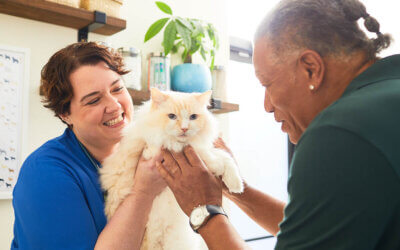Often, veterinary team members get caught up in the busy moments of the practice. Receptionists check clients in and out, answer the phones and make appointments. Veterinary technicians provide nursing care to patients, client education, and aid in the diagnoses of patient diseases and illnesses. Veterinarians perform surgery, diagnose cases and prescribe medication. Practice managers create policies and procedures, analyze data and make decisions to move the practice in the up-direction.
So, where exactly does cultivating a memorable client experience fit into these tasks?
Customer service is a well-known word that often gets diluted and the full value of the term becomes lost. Customer service is defined by Investopedia as “the process of ensuring customer satisfaction with a product or service. Often, customer service takes place while performing a transaction for the customer”.[i]
The type of customer service your practice delivers contributes to the type of experience your clients have with your practice.
What does a memorable client experience look like?
For this discussion, lets focus on the client experience – and experience what this should look like in the veterinary practice. Ask yourself these questions:
- When a client calls the practice, what is their experience?
- When the client arrives to the practice, is their experience something to rave about to family and friends? Or could it best be described as mediocre?
- When the client interacts with the team, do they consistently create a warm, inviting experience that the customer can trust and build a relationship with?
- When the client checks out, do they feel like the money they spent was well worth the investment?
Honestly evaluate the client experience your practice delivers
 Don’t depend on the team to answer these questions. Instead, ask your clients directly. You see, cost is an issue in the absence of value. Your team must provide a memorable client experience, like no other place of business. We the team, don’t experience what the client experiences, and in fact, we see the whole experience through a different lens. The team may feel they provided an excellent client experience, but rarely does a client feel the same. Why, you ask? Evaluate a few areas of your practice:
Don’t depend on the team to answer these questions. Instead, ask your clients directly. You see, cost is an issue in the absence of value. Your team must provide a memorable client experience, like no other place of business. We the team, don’t experience what the client experiences, and in fact, we see the whole experience through a different lens. The team may feel they provided an excellent client experience, but rarely does a client feel the same. Why, you ask? Evaluate a few areas of your practice:
- How easy is the process to set up an appointment? Is your practice easy to do business with? From the team’s perspective, this answer will most likely be yes!
- Are your clients greeted by name on arrival at the practice and escorted promptly into the exam room? Of course, your team will say “yes, when time permits”.
- What are your wait times from the point a client arrives until they see the doctor, and then from seeing the doctor to walking out the door? This answer will likely vary, and the team will often peg walk-ins and emergencies for the delay.
- How much client education do clients receive in your practice? Do they need to conduct their own research on the Internet when they get home? Often, the team answers this question “of course we educate them.” But did the clients ‘get it’?
[bctt tweet=”Cost is an issue in the absence of value. Your team must provide a memorable client experience, to differentiate your veterinary practice from your competitors.”]
A majority of veterinary practices offer exams, vaccinations, wellness care, diagnostics, and surgery, just to name a few. So, what differentiates your hospital? Remember, your clients never went to veterinary school, so they don’t know what good veterinary medicine is. But every pet owner knows what a memorable client experience is — and they place value on the experience they have in your practice. That, my friends, is what differentiates you from your veterinary neighbor.
Blend technology, process and compassion to delight clients and patients

What should the answers be for the above questions?
-
How easy is the process to set up an appointment? Is your practice easy to do business with?
Clients should be able to make appointments by any method that is most convenient and comfortable for them: phone, email, text, or app. Integrate technology so that all options are available, and ensure the team follows through with immediate response. Technology allows the client experience to be tailored to their needs and can greatly improve the efficiency of your business. A practice that integrates email, text or app-based appointment scheduling can eliminate (on average) 10 phone calls per hour, or 80 calls per day. The result — the client is able to schedule their appointment their way while saving the practice time and allowing the receptionist to engage with the clients at the counter.
[bctt tweet=”Practices that integrate email, text or app-based appointment scheduling can eliminate (on average) 10 phone calls per hour, or 80 calls per day.”]
-
Are your clients greeted by name on arrival at the practice and escorted promptly into the exam room?
Receptionists should know clients and pets by name when an appointment has been scheduled. Greeting clients by name makes the client feel “special”, further enhancing the experience. Integrate technology to know who your clients are upon entry. Further, clients and patients should never be left to wait in the reception area. The wait and exposure to other patients and clients increases anxiety in pets (and clients) to what is sometimes an unmanageable level. A poor patient experience results in a poor client experience. Review FearFreePets.com for resources on creating exceptional patient experiences; your patients deserve it, and your clients will love it!
-
What are your wait times from the point a client arrives until they see the doctor, and then from seeing the doctor to walking out the door?
The answer should be fairly close to the length of the appointment time. If the practice books 20-minute appointments, then a client should arrive and check out of the practice within 30 minutes (unless additional diagnostics are required). Most often, the inefficiencies of the team slow this process and significantly affect the client experience. Scrutinize internal processes to improve flow and efficiency in the practice.
[bctt tweet=”If a veterinary practice books 20-minute appointments, then clients should arrive and check out of the practice within 30 minutes.”]
-
How much client education do clients receive in your practice? Do they need to conduct their own research on the Internet when they get home?
39% of clients Google “pet healthcare” before arriving in the practice, while 20% Google “pet healthcare” after the exam.[ii] Do your clients fall into this category? Integrate technology so that customer education can be tailored to client needs. Some clients need paper brochures or handouts to take home; others may need videos or 3-D imaging to watch; while yet another subset may need models to hold and touch. Clients only retain 30% of the information presented to them in the exam room[iii]. Clients that understand what is being recommended are more likely to accept recommendations made by the team. What is your practice doing to increase client education retention?
Exceed client expectations the Ritz Carlton way
 Imagine for a moment that you are visiting the Ritz Carlton, where every Ritz team member has the authority and the autonomy to create a memorable client experience. While the bill may be expensive, the service and experience provided keeps their loyal customers returning with no complaints about the cost. And team members never need to ask a manager for permission. They just do it. They make the client experience phenomenal.
Imagine for a moment that you are visiting the Ritz Carlton, where every Ritz team member has the authority and the autonomy to create a memorable client experience. While the bill may be expensive, the service and experience provided keeps their loyal customers returning with no complaints about the cost. And team members never need to ask a manager for permission. They just do it. They make the client experience phenomenal.
Now back to reality. How will you translate the valuable lessons from the Ritz Carlton to the day to day of your veterinary practice?
Does your team have the autonomy and authority to create a dynamic client experience?
- What can be done in your practice to enhance the client experience, so that cost is never an issue and value is always present?
- How can technology increase the efficiency of your team to exceed client expectations?
The choice is yours. What will you do today?
[ii] Bayer Veterinary Care Usage Study, 2011
[iii] Prendergast, H, Front Office Management for the Veterinary Team, 2nd ed; Elsevier; 2014.
Heather Prendergast, RVT, CVPM, SPHR is an Education Development Specialist at Patterson Veterinary. She lectures internationally and has authored a book authored and several articles on leadership and management structure in the veterinary practice. She can be reached at [email protected].



